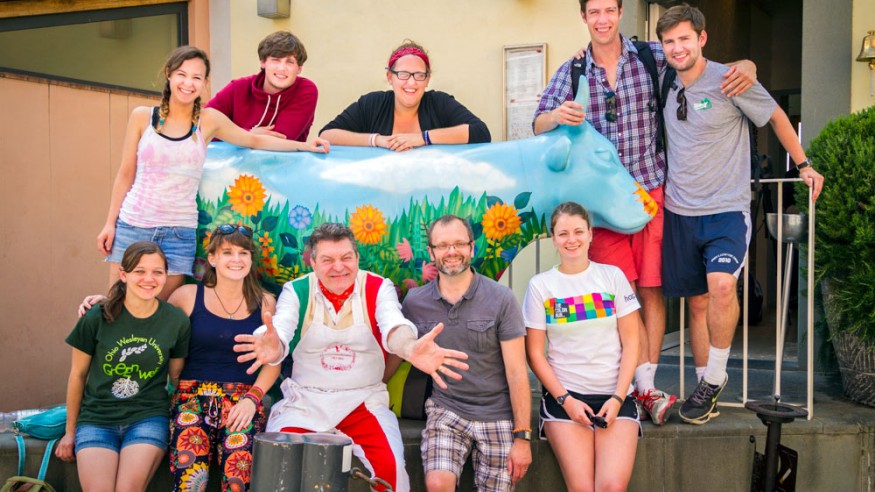
The Real Mediterranean Diet
Ohio Wesleyan University professor Chris Fink and his students visit Dario Cecchini, the world’s most famous butcher, during a travel-learning experience in Italy. (Photo courtesy of the Umbra Institute)
[Editor’s Note: This news release was issued by the Umbra Institute during a recent OWU travel-learning experience in Italy.]
PERUGIA, Italy— “Mi chiamo Dario Cecchini, e ho 250 anni” (My name is Dario Cecchini, and I’m 250 years old), says the man the LA Times calls “the most famous butcher in the world.” All jokes aside, Dario was referring to his extensive family history, as he is an eighth-generation butcher.
Earlier this month, professor Christopher Fink, along with 10 Ohio Wesleyan University students, visited Cecchini’s butcher shop in Panzano in Chianti, a small town in the foothills of Tuscany. Fink’s course, Italy and the Mediterranean Diet – Myths and Realities, explores the day-to-day norms of food consumption by Italians, along with traditional food practices that still exist in the culture. Food is an important topic at the Umbra Institute, whose interdisciplinary Food Studies Program has hosted important scholars in the field over the past three years.
Cecchini definitely does not fit the stereotype of a small-town Tuscan butcher; he sports spiked hair, a bandana, and Crocs, and is just as likely to play AC/DC or Led Zeppelin on his stereo as Vivaldi.
Using a modern take on yesterday’s traditions, Cecchini’s philosophy rests on “the whole cow approach.”
“My father was a butcher, but I never had a steak until I was 18,” Cecchini explained. “We ate what was left over from the butcher shop, and my parents used peasant recipes to turn these cuts into tasty dishes, instead of throwing them away like most butchers do now. The whole cow menu: That’s conservation, that’s sustainability, that’s delicious, and that’s what we need to do.”
Cecchini’s comments coincide with Fink’s program curriculum, which encourages students to look at what would actually be considered a Mediterranean diet, and how those practices coincide with health, chronic disease, and food culture in Italy. Through field trips that take students out of the classroom, students are exposed diverse examples of real-world food production and consumption in Italy.
Professor Fink commented: “While meat as a food is not normally central to the Mediterranean Diet, the visit to Dario’s really highlighted the philosophical underpinnings of ethical, thoughtful meat consumption that is key, and can support health in the context of the Mediterranean Diet. Plus, it was a lot of fun to get to meet such a passionate advocate for good, clean, and fair food.”
Sarah Shulman, one of the OWU students, commented: “This trip showed food typical to the region it comes from. It also showed the respect and ethical way of treating the animal that is to be eaten, and how it matches up with the Mediterranean diet.”
After an amazing meal at Cecchini’s restaurant, Fink and his students were back at the Umbra Institute, an American study abroad program located in Perugia, the central Italian city known for its chocolate and 35,000 university students.
About the Umbra Institute:
The Umbra Institute is an American study abroad program located in the central Italian city of Perugia. Often called a “big university town in a small Italian city,” Perugia is the ideal setting to study abroad in Italy, with fine arts, business, and liberal arts courses.
